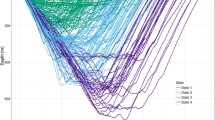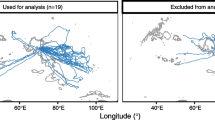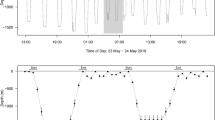Abstract
Recording the activity of animals as they migrate or forage has proven hugely advantageous to understanding how animals use their environment. Where animals cannot be directly observed, the problem remains of how to identify distinct behaviours that represent an animal’s decision-making process. An excellent example of this problem is that of foraging penguins, which travel to sea to find prey to provision their young. Without direct sampling of the prey field, we cannot calibrate patterns of movement with prey capture, and therefore we cannot determine how different activities link to decision-making. To overcome this, we use a hidden markov model (HMM), which is a machine-learning technique that seeks to identify the underlying states of a system from observable outputs. We apply HMM to determine classes of behaviour from repetitive dives. We take dive data from 103 breeding macaroni penguins at Bird Island, South Georgia, for which we have measures of weight gain over a trip. We identify two classes of behaviour; those of short-shallow and long-deep dives. Using these two behaviours, we calculate the transition probabilities between these states and analyse these data to determine what predicts variation in the transition probabilities. We found that the stage of reproduction during a season, the sex and year of an individual influenced the probability of transition between long-deep and short-shallow sequential dives. We also found differences in the hourly transition rates between the four reproductive stages (incubation, broodguard, crèche and premoult) over a daily cycle. We conclude that this application of HMMs for behavioural switching is potentially useful for other species and other types of recorded behaviour.






Similar content being viewed by others
References
Arnold K, Zuberbühler K (2006) The alarm-calling system of adult male putty-nosed monkeys, Cercopithecus nictitans martini. Anim Behav doi:10.1016/j.anbehav.2005.11.017
Barlow KE, Croxall JP (2002) Seasonal and inter-annual variation in foraging range and habitat of macaroni penguins Eudyptes chrysolophus at South Georgia. Mar Ecol Prog Ser 232:294–304
Barlow KE, Boyd IL, Croxall JP, Reid K, Staniland IJ, Brierley AS (2002) Are penguins and seals in competition for Antarctic krill at South Georgia? Mar Biol doi:10.1007/s00227-001-0691-7
Berrow SD, Croxall JP (2001) Provisioning rate and attendance patterns of wandering albatross at Bird Island, South Georgia. Condor 103:230–239
Biro D, Freeman R, Meade J, Roberts SJ, Guilford T (2007) Pigeons combine compass and landmark guidance in familiar route navigation. Proc Natl Acad Sci USA doi:10.1073/pnas.0701575104
Bisset C, Bernard RTF (2007) Habitat selection and feeding ecology of the cheetah (Acinonyx jubatus) in thicket vegetation: is the cheetah a savanna specialist? J Zool doi:10.1111/j.1469-7998.2006.00217.x
Bost CA, Handrich Y, Butler PJ, Fahlman A, Halsey LG, Woakes AJ, Ropert-Coudert Y (2007) Changes in dive profiles as an indicator of feeding success in king and Adélie penguins. Deep-Sea Res, Part II doi:10.1016/j.dsr2.2006.11.007
Bost CA, Thiebot JB, Pinaud D, Cherel Y, Trathan PN (2009) Where do penguins go during the inter-breeding period? Using geolocation to track the winter dispersion of the macaroni penguin. Biol Lett doi:10.1098/rsbl.2009.0265
Boyd IL, Arnould JPY, Barton T, Croxall JP (1994) Foraging behaviour of Antarctic fur seals during periods of contrasting prey abundance. J Anim Ecol 63:703–713
Burns JG (2005) Impulsive bees forage better: the advantages of quick, sometimes inaccurate foraging decisions. Anim Behav 70:e1–e5
Caro TM (1994) Cheetahs of the serengeti plains: group living in an asocial species. University of Chicago Press, Chicago
Cazelles B, Chavez M, Berteaux D, Ménard F, Vik JO, Jenouvrier S, Stenseth NC (2008) Wavelet analysis of ecological time series. Oecologia doi:10.1007/s00442-008-0993-2
Cooper AB, Petorelli N, Durant SM (2007) Large carnivore menus: factors affecting hunting decisions by cheetahs in the Serengeti. Anim Behav doi:10.1016/j.anbehav.2006.06.013
Cresswell KA, Tarling GA, Burrows MT (2007) Behaviour affects local-scale distributions of Antarctic krill around South Georgia. Prog Ser, Mar Ecol. doi:10.3354/meps06908
Cresswell KA, Wiedenmann J, Mangel M (2008) Can macaroni penguins keep up with climate- and fishing-induced changes in krill? Polar Biol doi:10.1007/s00300-007-0401-0
Croxall JP, Reid K, Prince PA (1999) Diet, provisioning and productivity responses of marine predators to differences in availability of Antarctic krill. Mar Ecol Prog Ser 177:115–131
Croxall JP, Silk JRD, Phillips RA, Afanasyev V, Briggs DR (2005) Global circumnavigations: tracking year-round ranges of non-breeding albatrosses. Science doi:10.1126/science.1106042
Dawkins MS (2007) Observing animal behaviour: design and analysis of quantitative controls. Oxford University Press, USA
de Craen S, Commandeur JJF, Frank LE, Heiser WJ (2006) Effects of group size and lack of sphericity on the recovery of clusters in K-means cluster analysis. Multivar Behav Res doi:10.1207/s15327906mbr4102_2
Edwards AM, Phillips RA, Watkins NW, Freeman MP, Murphy EJ, Afanasyev V (2007) Revisiting Lévy flight search patterns of wandering albatrosses, bumblebees and deer. Nature doi:10.1038/nature06199
Elliot KH, Bull RD, Gaston AJ, Davoren GK (2009) Underwater and above-water search patterns of an Arctic seabird: reduced searching at small spatiotemporal scales. Behav Ecol Sociobiol doi:10.1007/s00265-009-0801-y
Everson I (ed) (2000) Krill: biology, ecology and fisheries. Blackwell Science, Oxford
Fanke A, Caelli T, Hudson RJ (2004) Analysis of movements and behavior of caribou (Rangifer tarandus) using Hidden Markov models. Ecol Modell doi:10.1016/j.ecolmodel.2003.06.004
Froget G, Gauthier-Clerc M, Le Maho Y, Handrich Y (1998) Is penguin banding harmless? Polar Biol 20:409–413
Gauthier-Clerc M, Gendner J-P, Ribic CA, Fraser WR, Woehler EJ, Descamps S, Gilly C, Le Bohec C, Le Maho Y (2004) Long-term effects of flipper bands on penguins Proc R Soc Lond B Biol doi:10.1098/rsbl.2004.0201
Green JA, Butler PJ, Woakes AJ, Boyd IL (2002) Energy requirements of female macaroni penguins breeding at South Georgia. Funct Ecol 16:671–681
Green JA, Butler PJ, Woakes AJ, Boyd IL (2003) Energetics of diving in macaroni penguins. J Exp Biol doi:10.1242/jeb.00059
Green JA, Boyd IL, Woakes AJ, Warren NL, Butler PJ (2005) Behavioural flexibility during year-round foraging in macaroni penguins. Mar Ecol Prog Ser doi:10.3354/meps296183
Guilford T, Roberts S, Biro D, Rezek I (2004) Positional entropy during pigeon homing II: navigational interpretation of Bayesian latent state models. J Theor Biol doi:10.1016/j.jtbi.2003.07.003
Guilford T, Meade J, Willis J, Phillips RA, Boyle D, Roberts S, Collett M, Freeman R, Perrins CM (2009) Migration and stopover in a small pelagic seabird, the Manx shearwater Puffinus puffinus: insights from machine learning. Proc R Soc Lond B Biol doi:10.1098/rspb.2008.1577
Halsey LG, Boast C-A, Handrich Y (2007) A thorough and quantified method for classifying seabird diving behaviour. Polar Biol doi:10.1007/s00300-007-0257-3
Hart T, Fitzcharles E, Trathan PN, Coulson T, Rogers AD (2009) Testing and improving the accuracy of discriminant function tests: A comparison between morphometric and molecular sexing in macaroni penguins. Waterbirds doi:10.1675/063.032.0309
Hart T, Coulson T, Trathan PN (2010) Time series analysis of archival tagging data: new approaches to larger data sets. Anim Behav doi:10.1016/j.anbehav.2009.12.033
Hennicke JC, Culik BM (2005) Foraging performance and reproductive success of Humboldt penguins in relation to prey availability. Mar Ecol Prog Ser 296:173–181
Houston AI, Carbone C (1992) The optimal allocation of time over the dive cycle. Behav Ecol 3:255–265
Jenouvrier S, Caswella H, Barbraud C, Holland M, Stroeve J, Weimerskirch H (2009) Demographic models and IPCC climate projections predict the decline of an emperor penguin population. Proc Natl Acad Sci USA doi:10.1073/pnas.0806638106
Johnson CJ, Parker KL, Heard DC, Gillingham MP (2006) Unrealistic animal movement rates as behavioural bouts: a reply. J Animal Ecol 75:303–308
Jonsen ID, Myers RA, Flemming JM (2003) Meta-analysis of animal movement using state-space models. Ecology 84:3055–3063
Jonsen ID, Flemming JM, Myers RA (2005) Robust State-Space Modelling of Animal Movement Data. Ecology doi:10.1890/04-1852
Jonsen ID, Myers RA, James MC (2006) Robust hierarchical state-space models reveal diel variation in travel rates of migrating leatherback turtles. J Anim Ecol doi:10.1111/j.1365-2656.2006.01129.x
Kalman RE, Bucy RS (1961) New results in linear filtering and prediction theory. J Basic Eng 83:95–108
Kramer DL (1988) The behavioral ecology of air breathing by aquatic animals. Can J Zool 66:89–94
Luque S, Guinet C (2007) A maximum likelihood approach for identifying dive bouts improves accuracy, precision and objectivity. Behaviour doi:10.1163/156853907782418213
Macdonald IL, Raubenheimer D (2007) Hidden Markov Models and animal behaviour. Biometr J 37:701–712
Manly BFJ, McDonald LL, Thomas DL (2002) Resource selection by animals, 2nd edn. Springer, Berlin
Markov AA (1971) Extension of the limit theorems of probability theory to a sum of variables connected in a chain. Wiley, London Reprinted in Appendix B of: R Howard Dynamic Probabilistic Systems, vol 1: Markov Chains
Montenbruck O, Pfleger T (2005) Astronomy on the personal computer, 4th edn. Springer, Berlin
Murray DL, Fuller MR (2000) A critical review of the effects of marking on the biology of vertebrates. In: Boitani L (ed) Research techniques in animal ecology. Columbia University Press, New York, pp 15–64
Naito Y (2007) How can we observe the underwater feeding behaviour of endotherms? Polar Sci doi:10.1016/j.polar.2007.10.001
Naito Y, Asaga T, Ohyama Y (1990) Diving behaviour of Adélie penguins determined by Time-Depth Recorder. Condor 92:582–586
Nams VO (2006) Animal movement rates as behavioural bouts. J Anim Ecol doi:10.1111/j.1365-2656.2006.01047.x
Parejo D, White J, Danchin E (2007) Settlement decisions in blue tits: difference in the use of social information according to age and individual success. Naturwissenschaften 94:749–757
Patterson TA, Thomas L, Wilcox C, Ovaskainen O, Matthiopoulos J (2008) State-space models of individual animal movement. Trends Ecol Evol doi:10.1007/s00114-007-0253-z
Rendell L, Whitehead H (2005) Spatial and temporal variation in sperm whale coda vocalizations: stable usage and local dialects. Anim Behav doi:10.1016/j.anbehav.2005.03.001
Roberts S, Guilford T, Rezek I, Biro D (2004) Positional entropy during pigeon homing I: application of Bayesian latent state modelling. J Theor Biol doi:10.1016/j.jtbi.2003.07.002
Ropert-Coudert Y, Wilson RP (2005) Trends and perspectives in animal-attached remote sensing. Front Ecol Environ doi:10.1890/1540-9295(2005)003[0437:TAPIAR]2.0.CO;2
Safi K, Heinzle J, Reinhold K (2006) Species recognition influences female mate preferences in the Common European Grasshopper (Chorthippus biguttulus Linnaeus, 1758). Ethology doi:10.1111/j.1439-0310.2006.01282.x
Saunders RA, Brierley AS, Watkins JL, Reid K, Murphy EJ, Enderlein P, Bone DG (2007) Intra-annual variability in the density of Antarctic krill (Euphausia superba) at South Georgia, 2002–2005: within-year variation provides a new framework for interpreting previous ‘annual’ estimates of krill density. CCAMLR Sci 14:27–41
Sepulveda MA, Bartheld JL, Monsalve R, Gomez V, Medina-Vogel G (2007) Habitat use and spatial behaviour of the endangered southern river otter in riparian habitats of Chile: conservation implications. Biol Conserv doi:10.1016/j.biocon.2007.08.026
Shepard ELC, Wilson RP, Quintana F, Laich AG, Forman DW (2009) Pushed for time or saving on fuel: fine-scale energy budgets shed light on currencies in a diving bird. Proc R Soc Lond B Biol doi:10.1098/rspb.2009.0683
Sims DW, Southall EJ, Humphries NE, Hays GC, Bradshaw CJA, Pitchford JW, James A, Ahmed MZ, Brierley AS, Hindell MA, Morritt DM, Musyl MK, Righton D, Shepard ELC, Wearmouth VJ, Wilson RP, Witt MJ, Metcalfe JD (2008) Scaling laws of marine predator search behaviour. Nature doi:10.1038/nature06518
Soto NA, Johnson MP, Madsen PT, Díaz F, Domínguez I, Brito A, Tyack P (2008) Cheetahs of the deep sea: deep foraging sprints in short-finned pilot whales off Tenerife (Canary Islands). J Anim Ecol doi:10.1111/j.1365-2656.2008.01393.x
Stamps JA, Swaisgood RR (2007) Some place like home: experience, habitat selection and conservation biology. Appl Anim Behav Sci doi:10.1016/j.applanim.2006.05.038
Takahashi A, Dunn MJ, Trathan PN, Croxall JP, Wilson RP, Sato K, Naito Y (2004) Krill-feeding behaviour in a Chinstrap Penguin Pygoscelis antarctica compared with fish-eating in Magellanic Penguins Spheniscus magellanicus: a pilot study. Mar Ornithol 32:47–54
Trathan PN, Bishop C, Maclean G, Brown P, Fleming A, Collins MA (2008) Linear tracks and restricted temperature ranges characterise penguin foraging pathways. Mar Ecol Prog Ser doi:10.3354/meps07638
Tremblay Y, Cherel Y (2000) Benthic and pelagic dives: a new foraging behaviour in rockhopper penguins. Mar Ecol Prog Ser 204:257–267
Tremblay Y, Cherel Y (2003) Geographic variation in the foraging behaviour of rockhopper penguins. Mar Ecol Prog Ser 251:279–297
Weimerskirch H (2007) Are seabirds foraging for unpredictable resources? Deep-Sea Res, Part II doi:10.1016/j.dsr2.2006.11.013
Wikelski M, Kays RW, Kasdin NJ, Thorup K, Smith JA, Swenson GW (2007) Going wild: what a global small-animal tracking system could do for experimental biologists. J Exp Biol doi:10.1242/jeb.02629
Williams TD (1995) The penguins. Oxford University Press, Oxford, UK
Williams TD, Croxall JP (1991) Annual variation in breeding biology of macaroni penguins, Eudyptes chrysolophus, at Bird Island, South Georgia. J Zool 223:189–202
Wilson RP (1995) Foraging ecology. In: Williams TD (ed) The penguins. Oxford University Press, Oxford, pp 81–106
Wilson RP, McMahon C (2006) Devices on wild animals and skeletons in the cupboard. What constitutes acceptable practice? Front Ecol Environ 4:147–154
Wilson RP, Pütz K, Bost CA, Culik BM, Bannasch R, Reins T, Adelung D (1993) Diel dive depth in penguins in relation to diel vertical migration of prey: whose dinner by candlelight? Mar Ecol Prog Ser 94:101–104
Wilson RP, Putz K, Peters G, Culik B, Scolaro JA, Charrassin JB, Ropert-Coudert Y (1997) Long-term attachment of transmitting and recording devices to penguins and other seabirds. Wildlife Soc B 25:101–106
Wilson RP, Scolaro A, Grémillet D, Kierspel MAM, Larenti S, Upton J, Gellelli H, Quinta F, Frere E, Müller G, Straten MT, Zimmer I (2005) How do Magellanic penguins cope with variability in their access to prey? Ecol Monogr 75:379–401
Wilson RP, Shepard ELC, Liebsch N (2008) Prying into intimate details of animal lives: use of a daily diary on animals. Endanger Species Res doi:10.3354/esr00064
Wolf M, Frair JL, Merrill EH, Turchin P (2009) The attraction of the known: the importance of spatial familiarity in habitat selection in wapiti. Ecography 32:401–410
Acknowledgments
This work was funded by a Biotechnology and Biological Sciences Research Council studentship and by the British Antarctic Survey under the Ecosystems core science programme. The authors gratefully acknowledge the help of Jane Tanton and Chris Green for data collection. Stephen Roberts provided code to apply the HMM algorithm to tag data. Alison Beresford gave comments on the manuscript. Jaume Forcada provided support with General Additive Models, and Owen Jones provided useful discussion on sub-sampling data and data manipulation in R. Although the provisions of the Animals (Scientific Procedures) Act 1986 do not apply to South Georgia, BAS endeavours to follow the Act as closely as possible. All procedure on animals complied with the Scientific Committee of Antarctic Research (SCAR) Code of Conduct for Use of Animals for Scientific Purposes in Antarctica (2006).
Author information
Authors and Affiliations
Corresponding author
Additional information
Communicated by M. E. Hauber.
Rights and permissions
About this article
Cite this article
Hart, T., Mann, R., Coulson, T. et al. Behavioural switching in a central place forager: patterns of diving behaviour in the macaroni penguin (Eudyptes chrysolophus). Mar Biol 157, 1543–1553 (2010). https://doi.org/10.1007/s00227-010-1428-2
Received:
Accepted:
Published:
Issue Date:
DOI: https://doi.org/10.1007/s00227-010-1428-2




